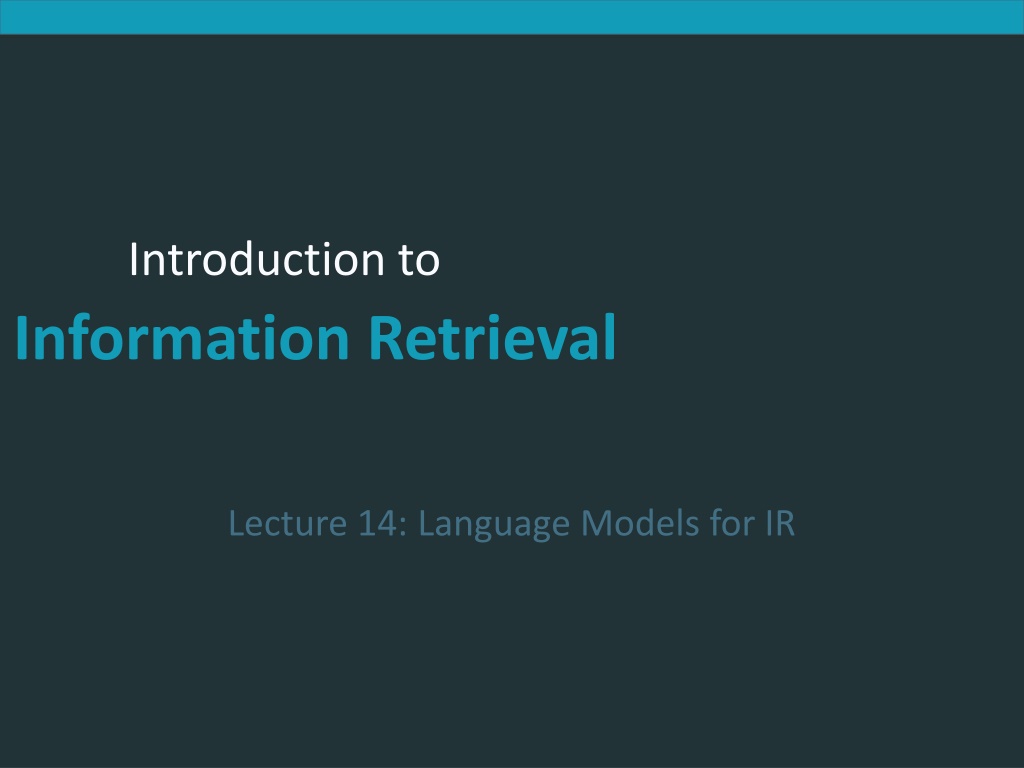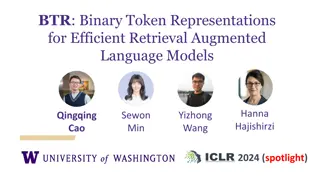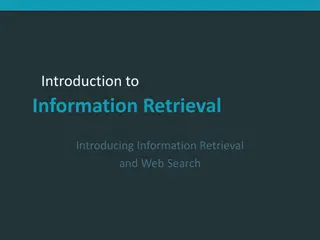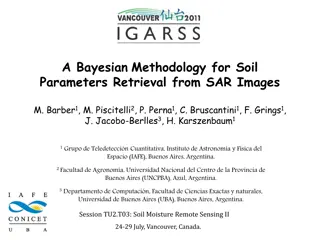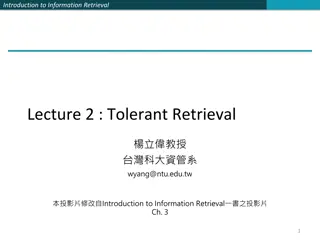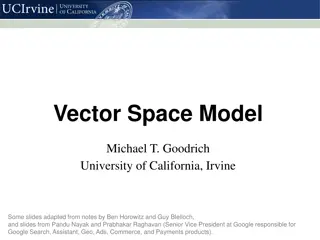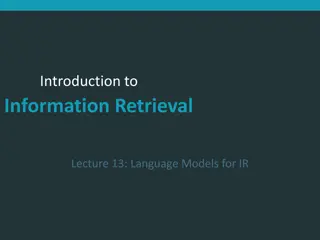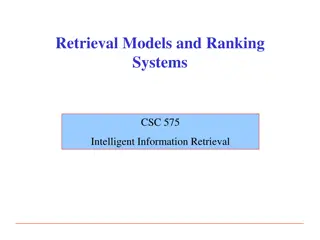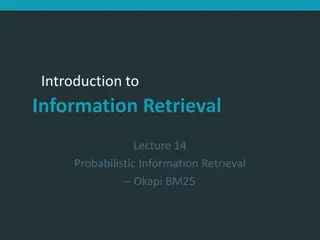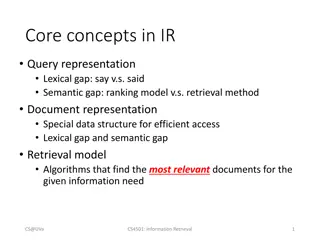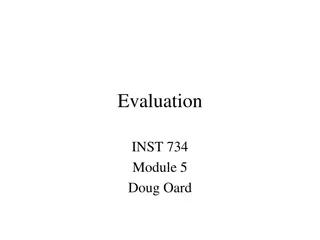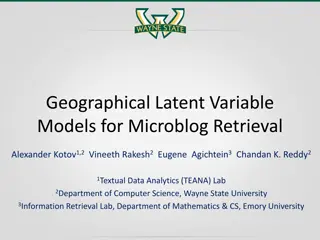Language Models for Information Retrieval
Language models (LMs) in information retrieval involve defining generative models for documents and queries, estimating parameters, smoothing to prevent zeros, and finding the most likely documents based on the query. By treating documents as language models, relevance to queries can be assessed based on probability distributions, enabling effective ranking of search results.
Download Presentation

Please find below an Image/Link to download the presentation.
The content on the website is provided AS IS for your information and personal use only. It may not be sold, licensed, or shared on other websites without obtaining consent from the author. Download presentation by click this link. If you encounter any issues during the download, it is possible that the publisher has removed the file from their server.
E N D
Presentation Transcript
Introduction to Information Retrieval Introduction to Information Retrieval Lecture 14: Language Models for IR
Introduction to Information Retrieval Using language models (LMs) for IR LM = language model We view the document as a generative model that generates the query. What we need to do: Define the precise generative model we want to use Estimate parameters (different parameters for each document s model) Smooth to avoid zeros Apply to query and find document most likely to have generated the query Present most likely document(s) to user
Introduction to Information Retrieval What is a language model? language model. We can view a finite state automaton as a deterministic I wish I wish I wish I wish . . . Cannot generate: wish I wish or I wish I . Our basic model: each document was generated by a different automaton like this except that these automata are probabilistic. 3
Introduction to Information Retrieval A probabilistic language model This is a one-state probabilistic finite-state automaton a unigram language model and the state emission distribution for its one state q1. STOP is not a word, but a special symbol indicating that the automaton stops. frog said that toad likes frog STOP P(string) = 0.01 0.03 0.04 0.01 0.02 0.01 0.02 = 0.0000000000048 4
Introduction to Information Retrieval A different language model for each document frog said that toad likes frog STOP P(string|Md1) = 0.01 0.03 0.04 0.01 0.02 0.01 0.02 = 0.0000000000048 = 4.8 10-12 P(string|Md2) = 0.01 0.03 0.05 0.02 0.02 0.01 0.02 = 0.0000000000120 = 12 10-12 P(string|Md1) < P(string|Md2) Thus, document d2is more relevant to the string frog said that toad likes frog STOP than d1 is. 5
Introduction to Information Retrieval Using language models in IR Each document is treated as (the basis for) a language model. Given a query q Rank documents based on P(d|q) P(q) is the same for all documents, so ignore P(d) is the prior often treated as the same for all d But we can give a prior to high-quality documents, e.g., those with high PageRank. P(q|d) is the probability of q given d. So to rank documents according to relevance to q, ranking according to P(q|d) and P(d|q) is equivalent. 6
Introduction to Information Retrieval Where we are In the LM approach to IR, we attempt to model the query generation process. Then we rank documents by the probability that a query would be observed as a random sample from the respective document model. That is, we rank according to P(q|d). Next: how do we compute P(q|d)? 7
Introduction to Information Retrieval How to compute P(q|d) We will make the same conditional independence assumption as for Naive Bayes. (|q|: length of q; tk : the token occurring at position k in q) This is equivalent to: tft,q: term frequency (# occurrences) of t in q Multinomial model (omitting constant factor) 8
Introduction to Information Retrieval Parameter estimation Missing piece: Where do the parameters P(t|Md). come from? Start with maximum likelihood (|d|: length of d; tft,d : # occurrences of t in d) we have a problem with zeros. A single t with P(t|Md) = 0 will make zero. We would give a single term veto power . For example, for query [Michael Jackson top hits] a document about top songs (but not using the word hits ) would have P(t|Md) = 0. That s bad. We need to smooth the estimates to avoid zeros. 9
Introduction to Information Retrieval Smoothing Key intuition: A non-occurring term is possible (even though it didn t occur), . . . . . . but no more likely than would be expected by chance in the collection. Notation: Mc: the collection model; cft: the number of occurrences of t in the collection; : the total number of tokens in the collection. We will use to smooth P(t|d) away from zero. 10
Introduction to Information Retrieval Mixture model P(t|d) = P(t|Md) + (1 - )P(t|Mc) Mixes the probability from the document with the general collection frequency of the word. High value of : conjunctive-like search tends to retrieve documents containing all query words. Low value of : more disjunctive, suitable for long queries Correctly setting is very important for good performance. 11
Introduction to Information Retrieval Mixture model: Summary What we model: The user has a document in mind and generates the query from this document. The equation represents the probability that the document that the user had in mind was in fact this one. 12
Introduction to Information Retrieval Example Collection: d1 and d2 d1 : Jackson was one of the most talented entertainers of all time d2: Michael Jackson anointed himself King of Pop Query q: Michael Jackson Use mixture model with = 1/2 P(q|d1) = [(0/11 + 1/18)/2] [(1/11 + 2/18)/2] 0.003 P(q|d2) = [(1/7 + 1/18)/2] [(1/7 + 2/18)/2] 0.013 Ranking: d2 > d1 13
Introduction to Information Retrieval Exercise: Compute ranking Collection: d1 and d2 d1 : Xerox reports a profit but revenue is down d2: Lucene narrows quarter loss but decreases further Query q: revenue down Use mixture model with = 1/2 P(q|d1) = [(1/8 + 2/16)/2] [(1/8 + 1/16)/2] = 1/8 3/32 = 3/256 P(q|d2) = [(1/8 + 2/16)/2] [(0/8 + 1/16)/2] = 1/8 1/32 = 1/256 Ranking: d2 > d1 14
Introduction to Information Retrieval Vector space (tf-idf) vs. LM The language modeling approach always does better in these experiments . . . . . . but note that where the approach shows significant gains is at higher levels of recall. 15
Introduction to Information Retrieval LMs vs. vector space model (1) LMs have some things in common with vector space models. Term frequency is directed in the model. But it is not scaled in LMs. Probabilities are inherently length-normalized . Cosine normalization does something similar for vector space. Mixing document and collection frequencies has an effect similar to idf. Terms rare in the general collection, but common in some documents will have a greater influence on the ranking. 16
Introduction to Information Retrieval LMs vs. vector space model (2) LMs vs. vector space model: commonalities Term frequency is directly in the model. Probabilities are inherently length-normalized . Mixing document and collection frequencies has an effect similar to idf. LMs vs. vector space model: differences LMs: based on probability theory Vector space: based on similarity, a geometric/ linear algebra notion Collection frequency vs. document frequency Details of term frequency, length normalization etc. 17
Introduction to Information Retrieval Language models for IR: Assumptions Simplifying assumption: Queries and documents are objects of same type. Not true! The vector space model makes the same assumption. Simplifying assumption: Terms are conditionally independent. Again, vector space model (and Naive Bayes) makes the same assumption. Cleaner statement of assumptions than vector space Thus, better theoretical foundation than vector space but pure LMs perform much worse than tuned LMs. 18
Introduction to Information Retrieval Three ways of developing language modeling approach Kullback-Leibler Divergence
Introduction to Information Retrieval Query Expansion in Language Modeling Basic Idea: We assume that the translation model can be represented by a conditional probability distribution T( | ) between vocabulary terms. The form of the translation query generation model:
